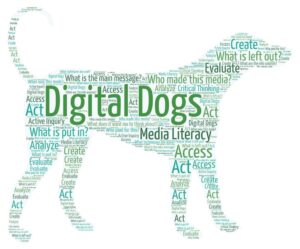
June 16, 2021
One of the primary things we want to seed with media literacy early and often goes beyond the digital literacy embedded in the new book series…We want kids to stop and think about every tap, click and swipe to consider where each of those actions will land and where algorithms may take them.
With that in mind, each of the books in the Digital Dogs Media Literacy Series tackles three core digital learning concepts that spin off the main topic (in The Secret of the Vanishing Bones, the first book, that would be data privacy).
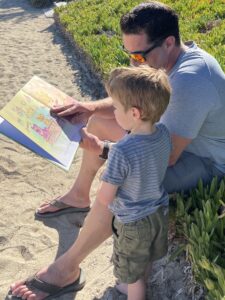
We ask parents and educators to help guide kids through the larger lens of media literacy inquiry, pondering things like “who made this, who paid for this, when, why and how” to explore the wide array of influences that come with media of all kinds.
From ads, vested interests, commercialism, and algorithmic recommendations to more general concepts, like ‘what does this media want me to think about’ it’s all a core part of developing ‘digital detective’ skills that kids can use to decipher the onslaught of media messages they encounter throughout their lives.
Without further ado, here’s the original post written for our main site, Shaping Youth…
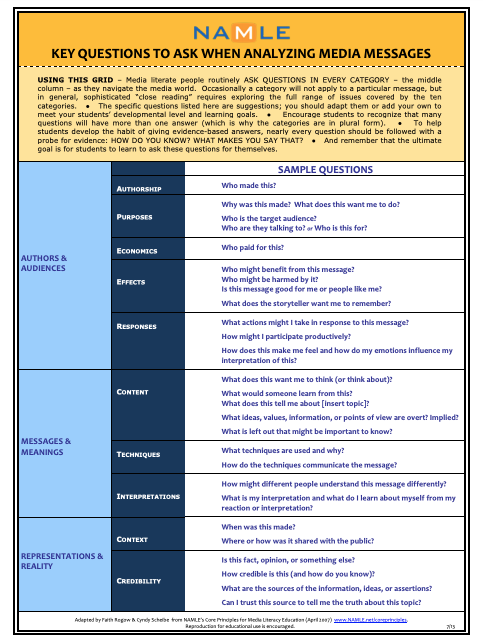 June 14, 2021 The National Association for Media Literacy Education (NAMLE) website is packed with media literacy teaching tools and resources that help us all “access, analyze, evaluate, create, and act, using all forms of communication” and one of them is this handy grid that summarizes some of the key questions we should all ask ourselves when evaluating media messages.
June 14, 2021 The National Association for Media Literacy Education (NAMLE) website is packed with media literacy teaching tools and resources that help us all “access, analyze, evaluate, create, and act, using all forms of communication” and one of them is this handy grid that summarizes some of the key questions we should all ask ourselves when evaluating media messages.
It seems only fitting to use this tool to put our new Digital Dogs book series itself through these same paces…
It’s a great way to “show and tell” how media analysis works, while getting to know how these critical thinking doggie detectives came to be and where the canine crew is headed as a series, provoking thoughtful inquiry on a wide array of tech topics and media machinations. So without further ado…here’s a primer on why these pups were created and how their tales dig into digital topics to unearth awareness and embed positive practices of inquiry so kids can navigate media messages throughout their lives.
And here’s NAMLE’s “key questions” pdf
Secret of the Vanishing Bones
Book One in the Digital Dogs Media Literacy Series
Who made this & why? Who paid for this?
 Amy Jussel, founder of Shaping Youth and a lifelong producer of media of all kinds created, wrote, funded, and published this passion project from concept through completion.
Amy Jussel, founder of Shaping Youth and a lifelong producer of media of all kinds created, wrote, funded, and published this passion project from concept through completion.
The idea sprang to life while tutoring early readers in underserved classrooms, noticing children were able to ‘click, tap and swipe’ long before they could read.
Children were very familiar with how to use tech devices, but not remotely aware of how the devices were using them.
With busy parents and not a lot of oversight, these children needed media mentoring instilled early on, so the topic of data privacy became the first storyline to embed basic inquiry about protecting personal information.
Amy hired her three top illustrator picks to execute a sample spread and see how well they would capture complex concepts and turn the storyboard into whimsical art. Despite language barriers, time zones and cost considerations, Amy selected Ilya Fortuna for his amazingly whimsical, colorful style and excellent understanding of the project scope, depth and intent of the work.
Fun fact: Amy is a writer/creative director in California (San Francisco Bay Area) and Ilya is a game designer/artist based in the Ukraine…Amy and Ilya have never met or even spoken! Together they’ve used online tools and technology platforms exclusively and have developed an ongoing friendship and camaraderie spanning continents.
Who is it for? Who is the target audience?
What does this want me to do?
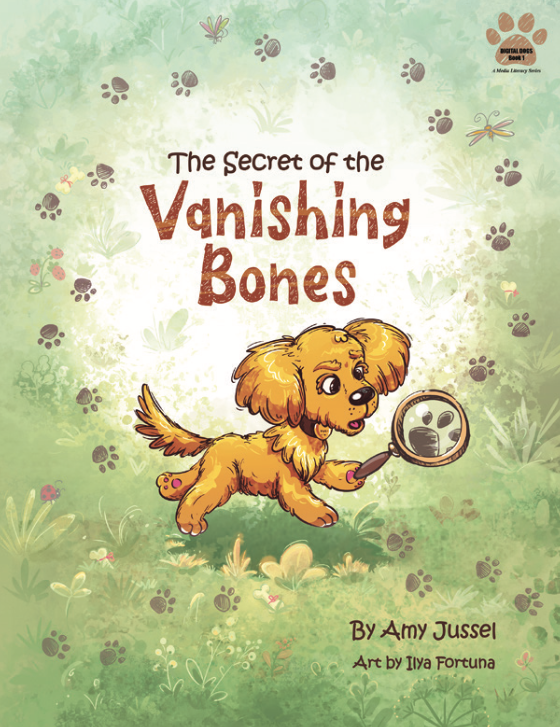 The series started as kind of a “puppy primer” for grades K-3, using dog tales to dig into topics that young kids don’t often consider but DO need to know.
The series started as kind of a “puppy primer” for grades K-3, using dog tales to dig into topics that young kids don’t often consider but DO need to know.
K-5 became the ‘level up’ lens for our book series and adjunct games and activities to embed early media literacy, guided by the success of watching kids in a “reading buddies” mentoring program, where older elementary kids read to younger ones.
The Parent & Educator Guide was designed for next level inquiry to build skills and sophistication using media literacy across all disciplines, with activities and probes expanding to grades 4-5.
Bonus?
Empowering older kids to ‘teach’ about media to younger ones ultimately uncorked some eye-opening loopholes, “what if” considerations and firsthand experiences that morphed into applied science as kids helped kids build habits to serve them well.
What techniques are used and why?
What points of view are overt or implied?
NAMLE and other media literacy orgs are quick to point out that ALL media constructs versions of reality and contain certain values, bias or lenses to see through and decipher.
The Digital Dogs Media Literacy series encourages thinking about all media as a construct starting at a very young age, so that tech topics, framing, characters, colors, expressions, words and plot points all prompt awareness about media in its many shapes and forms. We even creating coloring pages that get kids aware of media all around them so they recognize ALL messages are ripe for analysis.
 Ultimately, the goal is to get children to recognize that every ad, cereal box, textbook, tee-shirt or even school lesson embodies messages created by someone, with certain items included or excluded, and every message placed there for a reason.
Ultimately, the goal is to get children to recognize that every ad, cereal box, textbook, tee-shirt or even school lesson embodies messages created by someone, with certain items included or excluded, and every message placed there for a reason.
It takes detective work to drill into the subtext and curiosity to provoke early reasoning and reflection, “Why did she say that? What did she mean? How did the artist draw that dog’s emotion and what did it make me feel?”
Given the ‘suspension of disbelief’ (that dogs can talk and team up to tackle media mysteries) kids are able to read and relate to the stories acquiring informal learning about media literacy without really trying. It’s seamless, purposeful, embedded skill building, through fun, fresh insights BY kids for kids and shared AMONG kids.
Parents and Educators are along on the journey to facilitate, reflect and enhance the storytelling, but the “aha” moments forming productive inquiry habits for life come from the kids themselves.
When was this made? What is the source?
How credible is this (and how do you know?)
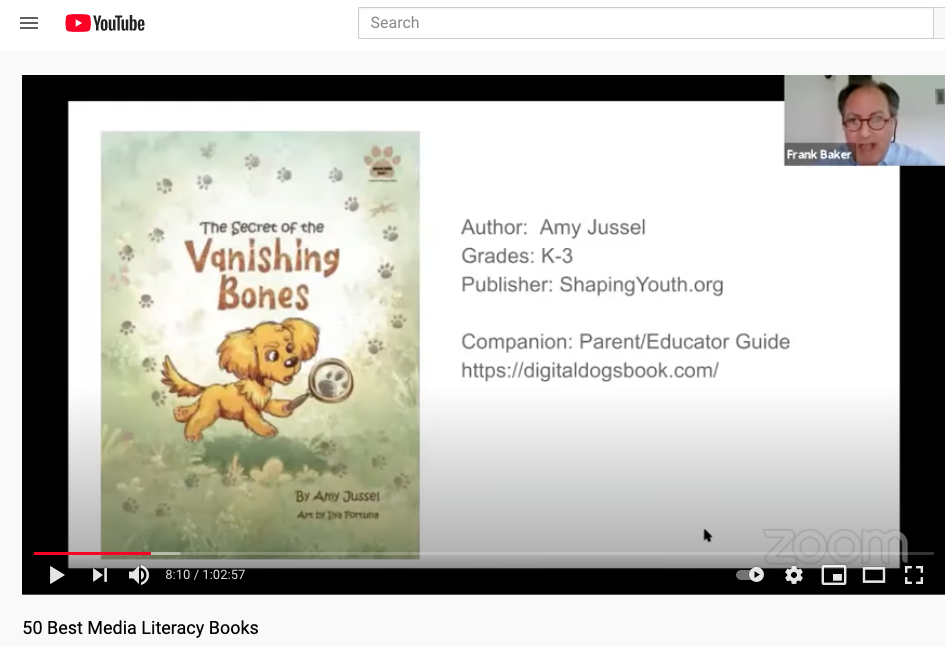 “Secret of the Vanishing Bones: Tracking the Data Trail” published May 1, 2021 as a ‘soft launch’ to get the production and fulfillment operations figured out, with a formal launch to the public July 1, 2021 in time for summer reading fun and gearing up for the fall school year post-covid chaos as kids venture back into libraries and schools in person.
“Secret of the Vanishing Bones: Tracking the Data Trail” published May 1, 2021 as a ‘soft launch’ to get the production and fulfillment operations figured out, with a formal launch to the public July 1, 2021 in time for summer reading fun and gearing up for the fall school year post-covid chaos as kids venture back into libraries and schools in person.
Shortly after publication, Secret of the Vanishing Bones: Tracking the Data Trail was honored to be selected for inclusion into the “Best 50 Media Literacy Books” webinar hosted by NAMLE co-founder Renee Hobbs and renowned Media Literacy education consultant Frank W. Baker supported by librarians and leaders in the field.
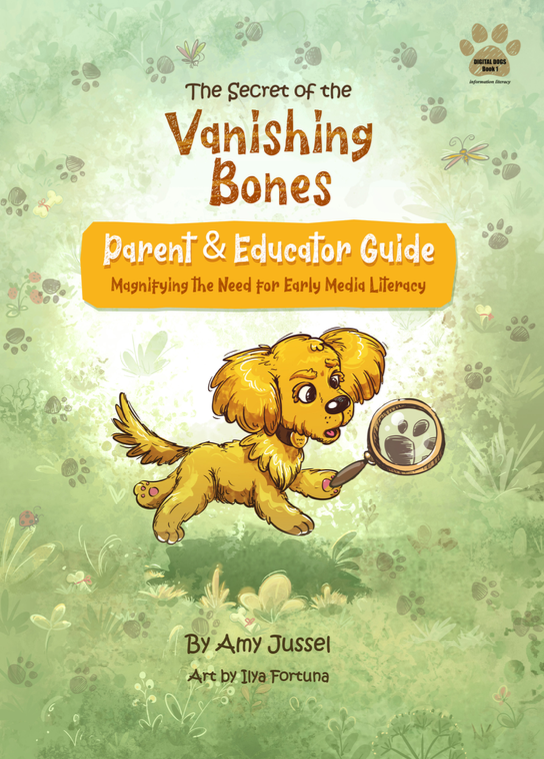 Currently being adapted into a links list by cover visual, age group and grade as a ‘cheat sheet’ of recommended reading to download in handy hotlink form, the full hour long video of best reads with a synopsis of each is watchable in its entirety on the Media Education Lab YouTube Channel. (Secret of the Vanishing Bones is about 8 minutes in, appx. 3rd on the list of 50).
Currently being adapted into a links list by cover visual, age group and grade as a ‘cheat sheet’ of recommended reading to download in handy hotlink form, the full hour long video of best reads with a synopsis of each is watchable in its entirety on the Media Education Lab YouTube Channel. (Secret of the Vanishing Bones is about 8 minutes in, appx. 3rd on the list of 50).
As for the fully vetted resources on the data privacy topic in the book itself, and curated compilation of digital and media literacy experts listed in the extensive Parent & Educator Guide, these represent leaders in the community with over a decade of pertinent knowledge. More resources via NAMLE.net.
The 20 page Parent & Educator Guide is a “companion piece” to the book, serving as an updatable e-resource packed with helpful talking points and activities that parents and educators can easily download, print and distribute at home or at school…There are even coloring pages for wee ones that inspire media literacy habits early.
By request, this will now also be adapted into a paperback version, though a FREE digital download is already accessible on our DigitalDogsBook.com website and via our colleagues at indie publisher/online book and toy store ReachAndTeach.com.Other online book distribution channels include Amazon, Barnes & Noble, Target, Books Inc. and more, with ebook, paperback and hardback offering ‘Amazon Prime’ services for free shipping. Regular updates and new activities and topics underway for book two and three will be previewed on the site and available for digital downloads. Testimonials and reviews are housed on the Amazon page itself.
How might different people understand the message differently?
What is my own interpretation or reaction?

Children understand the messages embedded in the book VERY differently, based on age, region, socioeconomic conditions, amount of tech savvy, and even race and relatability.
In casual focus groups with kids, some picked up on social emotional learning cues more than the digital literacy itself, while others brought up subtle points inherent in the story, like the homeless family of pups, or profiling by appearance and snap judgment.
Kids bring their own lens to storytelling and media forms, and each time we host a read aloud we learn something new about how kids interpret the story, outcomes, life lessons and adventures of this diverse pack of pups.
What is left out that might be important to know?
Each of the books prompts kids to take the role of digital dog detectives coming up with evidence-based answers, not just hunches.
“Why do you think that? How do you know? When and how did you come to that conclusion?”
Kids begin to close read the cues on each page to hunt for hints and telltale signs that encourage deeper thinking about ALL the media they consume. The series leaves out ‘judgment’ in favor of awareness with a tonality that is more of a “be aware” tenor than “beware.”
Technology and media itself are positioned as powerful tools which all too often do not come with any semblance of an ‘instruction guide’ so the digital dogs help put kids on the path to knowledge by unburying key questions through storytelling.
Where do the Digital Dogs Books go from here?
How can we dig deeper into media literacy?
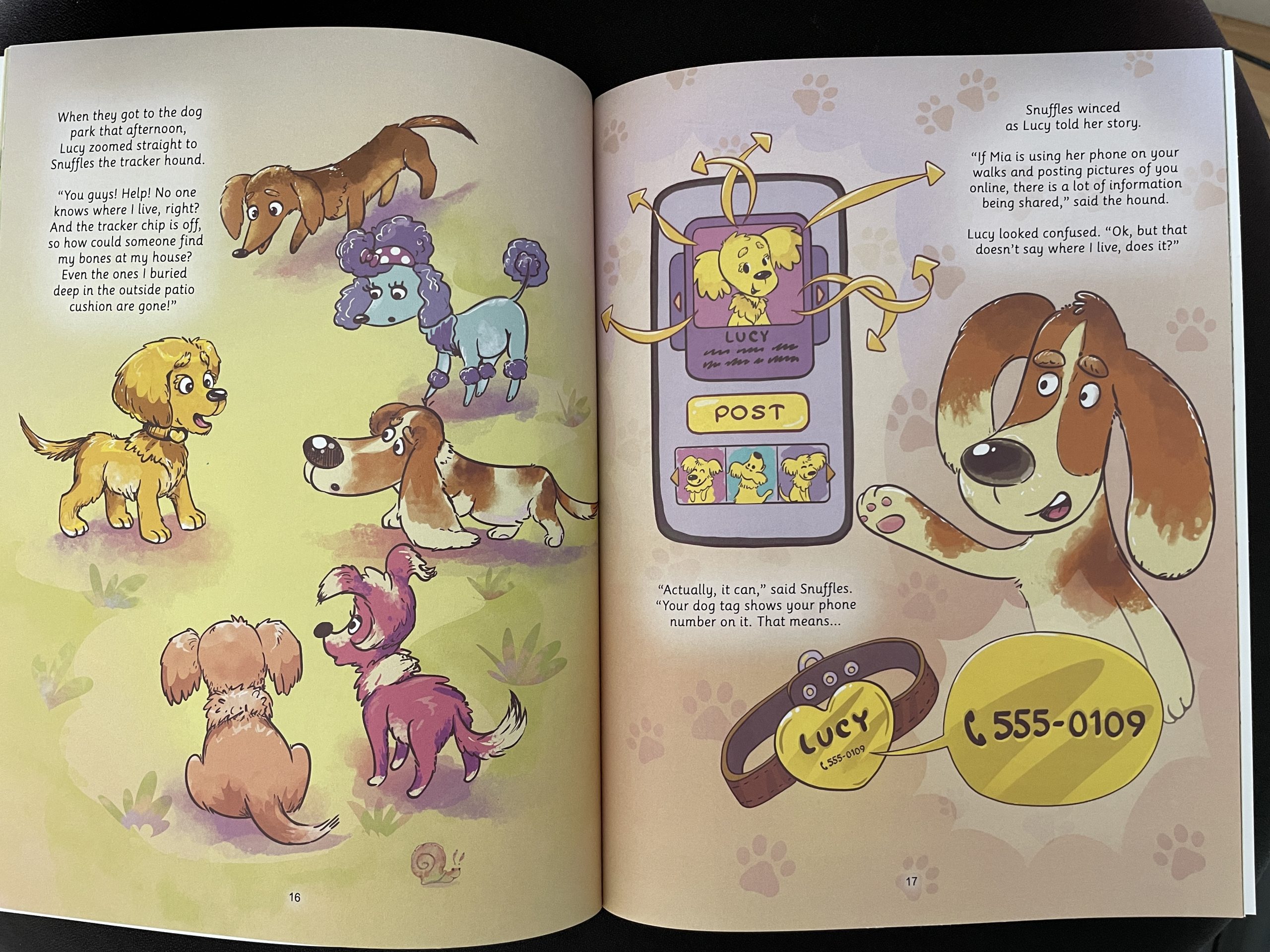 Parents and educators are core to seeding critical thinking, but they’re overloaded as it is, especially since older siblings and peers introduce younger ones to games, apps and videos without any guardrails.
Parents and educators are core to seeding critical thinking, but they’re overloaded as it is, especially since older siblings and peers introduce younger ones to games, apps and videos without any guardrails.
With the pandemic doubling screen time at home and in school via remote learning, now more than ever we need to build critical thinking skills EARLY to navigate with healthy skepticism and a keen eye of data awareness and digital safety to inoculate against misinformation and misuse on platforms.
Parents can’t be everywhere at once and teachers may not be privy to exposure at home; both are perpetually overwhelmed by task management to keep up to date with what media is consumed, so going directly to the kids themselves to instill awareness, savvy and inoculation against a steady stream of new media messages to help kids makes sense of what’s coming at them every nanosecond…As a nation, we just can’t wait around for media literacy legislation to become a core curriculum component, we need kids to be critical thinkers now!
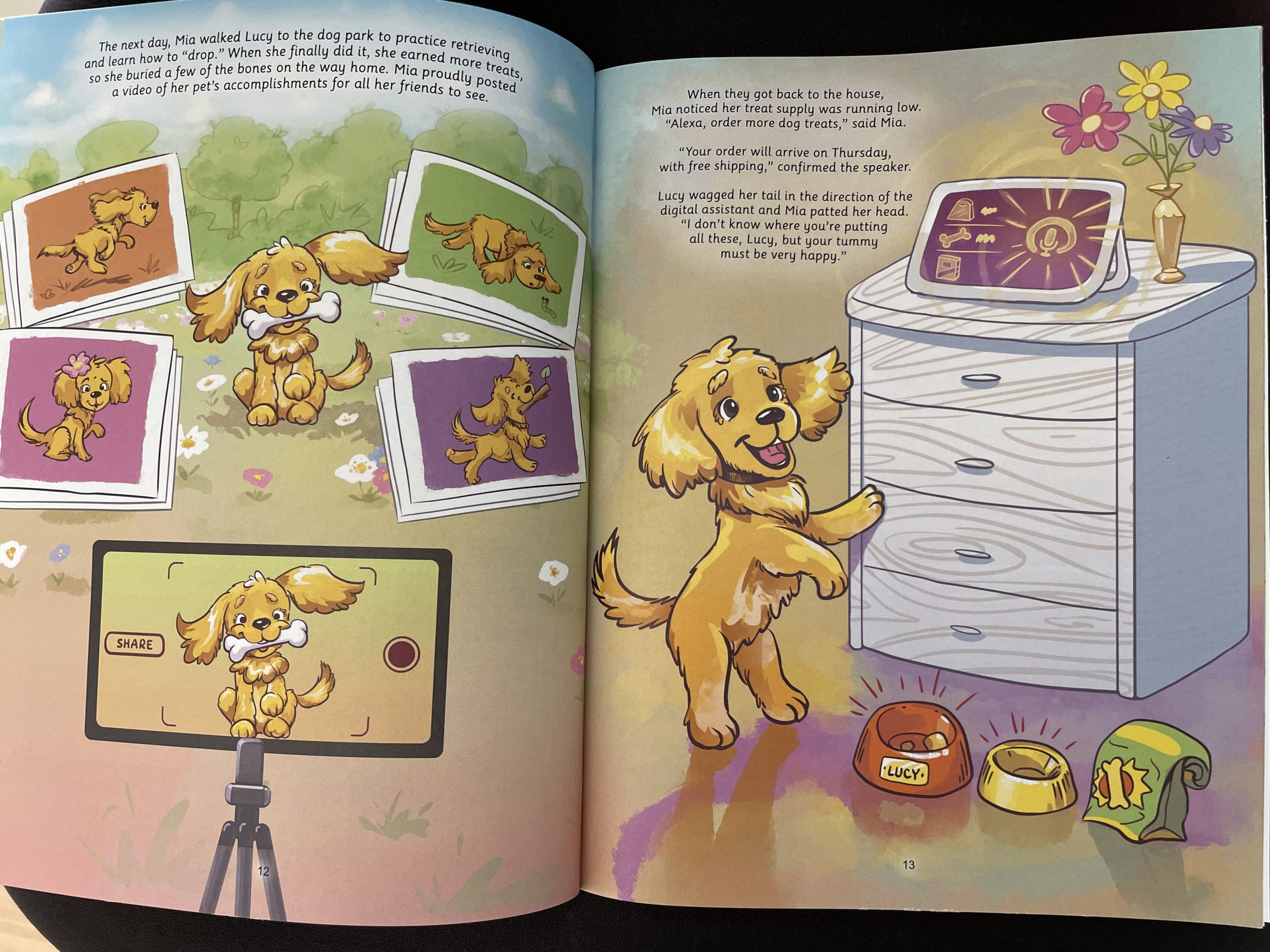 From algorithms, bots and bias, to facial recognition, artificial intelligence, and “rabbit holes” of unfiltered content where kids can spin into misinformation and media sharing that lacks factual foundation, the canine crew helps children unearth critical thinking to detect and guide inquiry among themselves.
From algorithms, bots and bias, to facial recognition, artificial intelligence, and “rabbit holes” of unfiltered content where kids can spin into misinformation and media sharing that lacks factual foundation, the canine crew helps children unearth critical thinking to detect and guide inquiry among themselves.
In books two and three we’ll be touching on commercialism, smart speakers, voice imprints and visual media as touchpoints to greater understanding, highlighting the pros and cons of the ever-evolving digital landscape and empowering kids to collect their own data and interpret their own ‘message’ and takeaway from each book, with opportunities to learn new skills and evaluate media in fun, fresh ways.
Ultimately, children (and ALL readers!) get in the HABIT of evaluating all aspects of media messaging, as well as becoming instinctively aware of who is serving each message and why the messages are being served.
If you enjoyed the book, please DO share your comments or leave a review!
